How to Use Your Learning Style to Get Ahead
- Blog Updates, Hear 2 Help You, Standard Blog
- hear 2 help you, learning styles
- December 19, 2018
Welcome to another week on Hear 2 Help You. Today we are going to be touching on my favourite topic, learning.
Most people would agree that not everyone learns the same way. Researchers (e.g. Cross & Tilson, 1997) also agree that people process information in various ways. Learning styles are generally thought of as the various ways people learn or prefer to learn.
It is not that people are inflexible and cannot learn in various ways. Educators believe that people learn best in one or two ways, and in order to maximize one’s potential, it is best to accommodate their learning styles.
Addressing your learning style may be beneficial because knowing your learning style will then allow you to use more effective learning strategies. The more you understand yourself, the more likely that you will be able to accept yourself (Martin & Potter, l 998).
This is important because you will know that it is “okay” if you learn differently from other people. Conversely, past research has shown that when you feel frustrated and confused in learning or training situations, you are more likely to withdraw, and lower your standards because you may think that there is something wrong with you.
Another aim is to account for learning differences between African American and Caucasian learning styles because it will help explain some of the differences in academic, and career achievement between these two groups.
Today, we are going to break each learning style down; our objective with this show is to help you learn more about yourself so that you can get ahead.
[wonderplugin_video iframe=”https://www.youtube.com/watch?v=raCRFmeXNnU” videowidth=600 videoheight=400 keepaspectratio=1 videocss=”position:relative;display:block;background-color:#000;overflow:hidden;max-width:100%;margin:0 auto;” playbutton=”http://hear-2-help.com/wp-content/plugins/wonderplugin-video-embed/engine/playvideo-64-64-0.png”]
Visual (Spatial)
Some people remember best what they see, so they prefer pictures, diagrams, flow charts, time lines, films, and demonstrations to access and understand new information. Sometimes they have trouble learning information presented through words.
If you are a visual learner, here are some thoughts you might have when you have to learn something new:
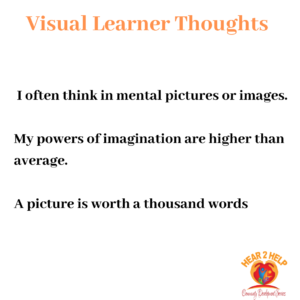
Here are a few ways to help yourself if you are a visual learner: 
- If the course material is predominantly verbal, try to find diagrams, schematics, photographs, flow charts, or any other visual representation. If you can’t find anything, try to make your own.
- Find videotapes, CDs, Youtube videos, or video podcasts about what you need to learn.
- Make a concept map where you’ll list key points, enclose them in boxes or circles, and draw lines with arrows between concepts to show connections.
- Color-code your notes with a highlighter. You can choose different criteria for this – for example, everything related to one topic could be yellow. Stickers in different colors are also a great way to present the material so it suits you better.
Verbal (Linguistic)
Let us move on to Verbal Learners. These are people who study better when the information is presented through words, by reading or listening. They prefer written or spoken explanations.
If you are a Verbal learner, here are some thoughts you might have when you have to learn something new:
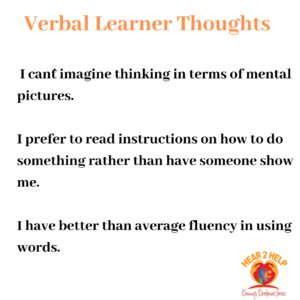
Here are a few ways to help yourself if you are a verbal learner:
- Write summaries or outlines of training material in your own words. By adapting the material, you will understand it better and could save yourself some time in the long run.
- Working in groups can be effective: you gain understanding of material by listening to others’ explanations and you learn even more when you do the explaining.
- Use repetition as a learning technique. It is most effective when there’s a short time interval between repetitions at the beginning and then you prolong it every time you successfully remember the lesson.
- Make associations of words or information that are hard to remember. For example, you can use some song lyrics as a memorization tool and link them with that information.
Aural (Auditory-Musical)
Musical learners thrive in an environment where they can not only hear music, but also hear patterns and relationships between sounds.
Are you one of those people who tap rhythmically on the desk with your pencil or pen? Do you love silly rhymes and chants? You don’t just like music, you connect to it on every level because you are a musical/rhythmic learners.
Here are 5 Characteristics of Music Learners
- You have music or a song in your heads most of the time.
- You may even say ordinary things in a singsong way.
- You enjoy singing and chanting.
- You are a very good listener.
- You tap and move to rhythm.
So, what can you do to learn something new a little faster? Here are some ideas for you:
Musical learners are more stimulated to learn when they are surrounded by music.
music.
Feel free to play some music you can listen to while you read, write or learn a new skill.
Pick the right kind of music ( Classical, Jazz, Tones) Pop songs with lyrics that are familiar will make you sing instead of help you focus on the task at hand.
Reading Out Loud
When it comes to reading, it is best for musical learners to read out loud as you have the chance to hear the sounds and patterns the English words and structures make.
You have been given a new project at work; read it out loud a few times.
You have to put together a bookcase; put some music on and read it to yourself.
Intonation Practice
Sentence stress, word stress, rising or falling intonation…these are the types of things musical learners should have no trouble with as you have a good ear for picking up on the differences.
When listening to instructions, write down the words that stick out to you, and review them later.
Physical (Kinesthetic)
In essence, If you are a kinesthetic learner, you process information best when you are physically engaged during the learning process.
Often, a kinesthetic learner has a hard time learning through traditional lecture-based schooling, or training because the body does not make the connection that you are doing something when you’re listening without movement.
Your brain is engaged, but your body is not, which makes it more difficult for you to process the information.
How do you know if you are a Kinesthetic Learner?
Do you have lots of energy?
Do you get antsy in long lecture classes or training sessions?
Have you ever noticed that it’s easier for you to study if someone asks you questions while you shoot hoops or walking around?
If you’re a kinesthetic learner, try these techniques to improve your comprehension, retention, and concentration while studying:
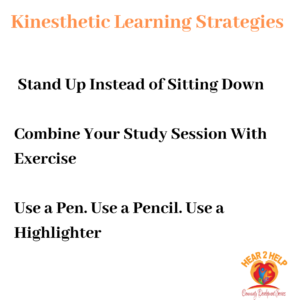 Stand Up Instead of Sitting Down
Stand Up Instead of Sitting Down
Standing up will improve your comprehension and retention? When you stand up, your body is more engaged and connected to the learning process.
Investing in a bookstand or standing desk may help you concentrate for longer periods of time and remember more of what you read.
Combine Your Study Session With Exercise.
Instead of plopping on the sofa with your notes, get up and do burpees or jumping jacks in between chapters.
Use a Pen. Use a Pencil. Use a Highlighter.
Underline important vocabulary or concepts while you read. Highlight and color code passages that connect to one another.
Logical (Mathematical)
 You know those people who are able to total up the amount of the lunch or dinner to the penny? Those are our next group of learners, the logics.
You know those people who are able to total up the amount of the lunch or dinner to the penny? Those are our next group of learners, the logics.
Logical-mathematical learners are typically methodical and think in logical or linear order. You are great at solving math problems in your head and you are drawn to logic puzzles and games.
People with this learning style often seek out rules and procedures and may be less assured when those don’t exist.
You may not be tolerant when others don’t follow logical sequences, rules, or procedures.
If you have someone on your team with this type of learning style, they can be very useful. Here are ways to utilize their strengths:
Have them contribute by making an agenda or list.
Have them set numerical goals, rank brainstorming ideas, putting steps into a sequence, keeping track of the progress of the group, and constructing data reports.
Allow them to troubleshoot problems using their logic, analysis, and math skills.
Social (Interpersonal)
If you have a strong social style, you communicate well with people, both verbally and non-verbally.
People listen to you or come to you for advice, and you are sensitive to their motivations, feelings or moods.
You listen well and understand other’s views. You may enjoy mentoring or counseling others.
You prefer to work through issues, ideas and problems with a group.
You thoroughly enjoy working with a ‘clicking’ or synergistic group of people.
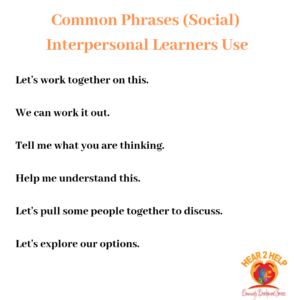
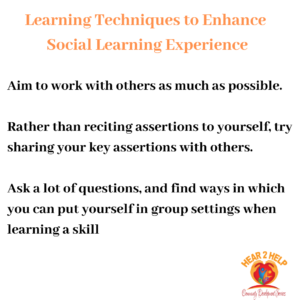
Solitary (Intrapersonal)
If you are a Intrapersonal Learner, you prefer to study independently and work autonomously
You may be introverted in your training sessions
You study situations by keeping to yourself and developing your self-awareness.
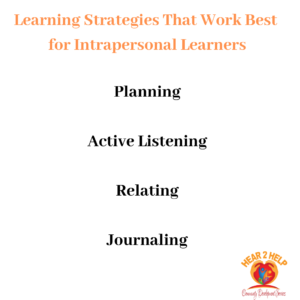
Planning
By identifying your objectives before your lessons, you clearly pave your intrapersonal learning paths.
Active Learning
Rather than simply reading, you will recall your lesson by being involved in it. That may mean asking questions in class, taking notes, recording lectures and solving problems.
Relating
You will be interested in your lesson if you feel a connection to it by sharpening your mind and deepening your understanding through tying new material to familiar topics. You establish a rewarding learning experience through common ground with stories and metaphors.
Journaling
Keeping track of your thoughts and feelings as you approach your classes can serve as a tool as you progress through school.


